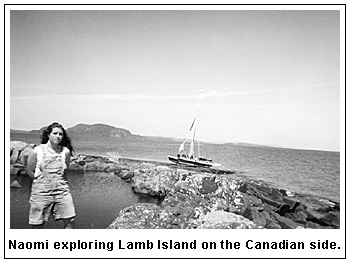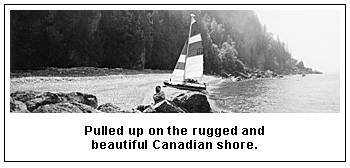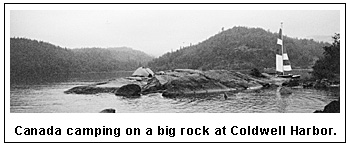|
Adventure Bound: A Father and Daughter
Circumnavigate the Greatest Lake in the World
By Carl Behrend
CHAPTER 13—THE CANADIAN SHORE
After what seemed to be an eternity of following
our compass through the fog, we finally spotted
the Canadian shoreline. Like a giant peeking
over the top of a fence, the mountaintops of
Corbeil Point welcomed us through the fog. By
this time, the waters had calmed and were nearly
as smooth as glass. We motored on using the
outboard. We checked our speed and our progress
on our handheld GPS unit.
With the dangerous open water crossing behind
us, and the beauty of the Canadian shore
drifting past at 5 ˝ miles per hour, I now truly
began to relax and enjoy the trip. A feeling of
elation enveloped us. The warm sunlight melted
away the fog. The beauty of the massive granite
rock mountains reaching down to the deep, clear
waters of Lake Superior soothed all thoughts of
any storms on the lake, past or future. They
were momentarily forgotten.

Canada was immediately beautiful and has not
ceased to awe me yet. We stopped at a little
fishery out of Batchawana Bay. The lake stayed
flat all day. But we motored to the Montreal
River. We saw a lot of loons and a lot of
awesome scenery.
Across Batchawana Bay and on toward Coppermine
Point, we glided across the calm waters, taking
in the unfolding beauty all around us.
Coppermine Point, on a calm day, is a reminder
that not all shipwrecks on the Great Lakes were
caused by collisions or heavy seas. Sometimes,
fire would destroy vessels on the lakes.
A spectacular fire off Coppermine Point, on the
night of June 26, 1907 claimed the 26-year-old
wooden Canadian steamer Batchawana, just
a few miles from Batchawana Bay. Down bound with
a load of iron ore from Fort William to the
Algoma Steel Company in Sault Ste. Marie, Ont.,
the 209-foot, 674-ton vessel somehow caught
fire. The ship was quickly engulfed in flames.
The crew took to the lifeboats and was saved.
But their ship had made her last trip.
Rounding Coppermine Point, we looked out on the
lake and saw the form of a fish tug out in the
distance. As we traveled on, we could see that
both of us were headed in the same direction. I
smiled and turned to Naomi.
I pointed to the fish tug and said, “It looks
like we’ll be having fresh fish for supper
tonight.”
“Can you do that? Buy fish right off their
boat?”
“Of course. The fishermen can eliminate the
middleman. We can get fresh fish.”

So both of our boats cruised toward the small
harbor, which was protected by some rocky
islands. The tug reached the harbor ahead of us.
They had already tied up and unloaded. The
harbor was rather quiet when we pulled up the
boat. It was nice to stretch our legs a little.
It was already early afternoon.

We made our way into the fish house and were
greeted by a woman behind a counter. We told her
about our trip and that we would like to buy
some fish. She weighed some trout and smoked
whitefish. She packed it in ice and a cardboard
box. We strapped the fish onto our boat, shoved
off and we were on our way.
Later that fall at Whitefish Point, one of the
fishermen from the tug was at the Edmund
Fitzgerald memorial service. The service is held
each Nov. 10 as a reminder of the terrible storm
that sank the great freighter and her crew. The
fisherman told those gathered how on the night
of the storm, the water along the shore here was
5 feet higher than normal. He also said that a
lot of wreckage from the Fitzgerald was washed
ashore near his fishery, including a lifeboat
from the Fitzgerald.
Naomi and I continued west along the rocky
Canadian coast. It was one of the best days of
my life. We motored along at top speeds of 6
mph. over waters that looked just like glass.
The water was so clear and pure we could see the
boulders and crevices below us to 30 feet deep.
Naomi lay sprawled out on one of the bows of the
boat, while I leaned back against the side stays
and took in the warmth of the sun. There are not
many days like this on Lake Superior. So when
they come along, enjoy them.
Up until this point, I still had doubts about
the trip. I kept asking myself questions. Am I
crazy taking this much time off work? Is it
foolhardy to attempt such a voyage? Will we make
it all the way around this time? But when the
weather is fine and the awesome beauty of the
rugged shoreline is drifting by you have no
doubts. The answer is yes, yes, yes, and more
than yes-this was the right thing to do. It was
the trip of a lifetime. There would be days
ahead when I would ask myself these questions
again. But for today, we just sat back and
enjoyed ourselves.
By late afternoon, we were approaching the mouth
of the Montreal River. So we pulled up at the
mouth in front of a small resort. Our 2 ˝-gallon
supply of gasoline was getting rather low from
running our motor all day. We walked up to the
resort. It consisted of a few small cabins. We
found the office and went inside.
The office served as a small store for the
visitors at the resort. The manager was a
friendly Canadian who said he was filling in for
his brother who was away. When we asked about
gasoline, he said they didn’t have gas. But he
said there was a place a few miles up the road.
He said he would give us a ride over there and
back. So we enjoyed the conversation as well as
the ride. This was the kind of nice people we
met along our way. They made the trip more
enjoyable.

Back at the river mouth, we launched the boat.
We could see Montreal Island in the distance.
The golden sun of late afternoon made everything
around appear even more beautiful. Setting our
course for the island, we planned to camp there
that night.
The lake was as smooth as glass again. The light
reflecting from its surface looked like mother
of pearl. This was a rare day indeed. So unlike
the day in May 1924 when the up bound steamer
Orinoco, with the barge Chieftain in
tow, encountered 60 mph. winds and sub-freezing
temperatures. The ship began leaking badly.
Captain Anthony Lawrence ordered the towline
dropped. Later, he ordered 19 of his men into
the lifeboats while he and two others remained
on board in an attempt to nurse the vessel to
shore. As the crew in the lifeboats struggled to
reach Montreal Island, they watched their
295-foot ship plunge to the bottom of the lake.
The brave captain, the chief engineer and the
wheelman all went down with the ship. The men in
the lifeboats were having a desperate struggle
to survive. Two of the men died of exposure.
Fortunately, the tug Gargantua happened
to be in the area. The tug picked up the 17 men
who had survived. They were alive, in part, due
to the heroism of the three who had gone down
with the ship. The Gargantua was able to
make it to the lee of Montreal Island and anchor
safely.
There is a resort we stopped at on the
Montreal River. I called Mommy. We bought some
food, got some gas. Then we headed out to
Montreal Island.
This is the seventh of a series of excerpts
from Carl Behrend’s book Adventure Bound. For
more
information on how to purchase books, CD’s or to
arrange bookings call (906) 387-2331 or
visit www.greatlakeslegends.com.
TOP
|